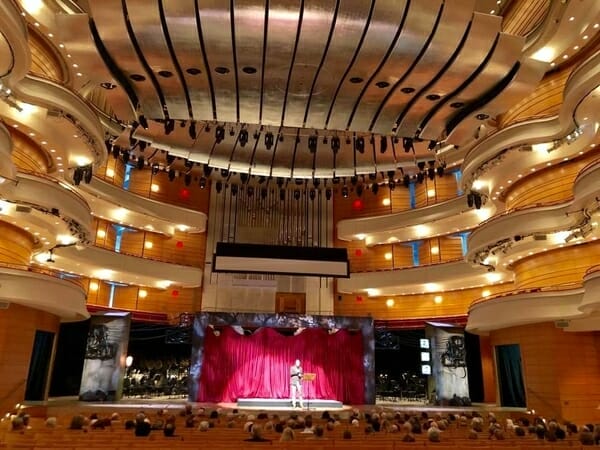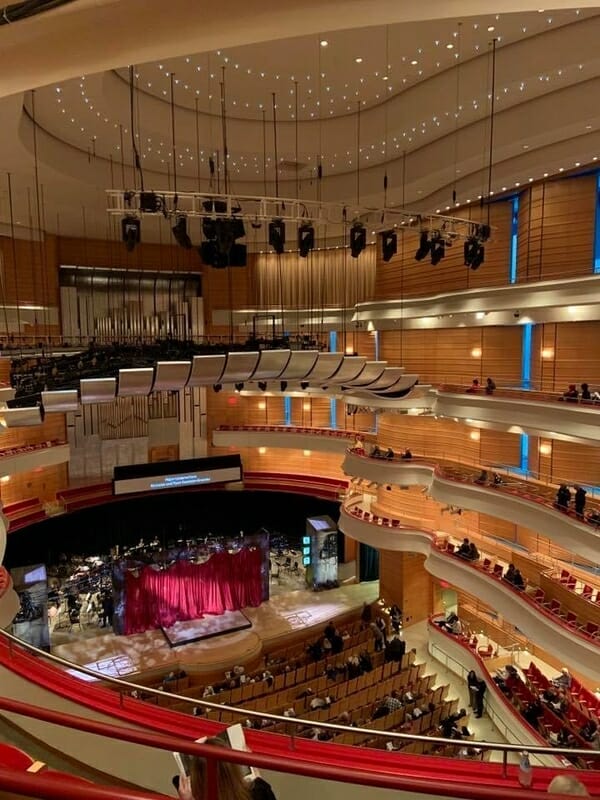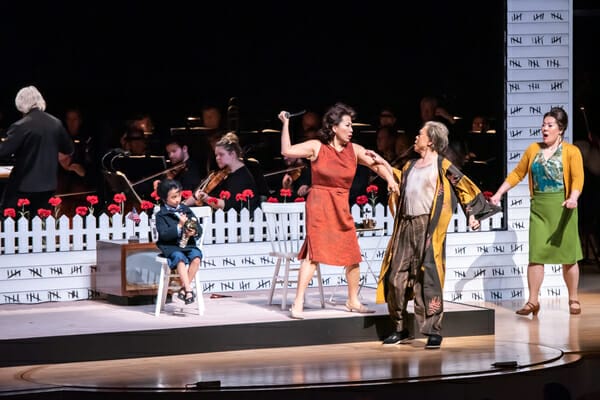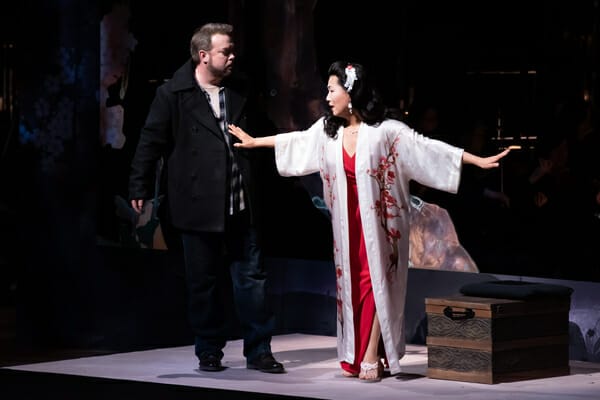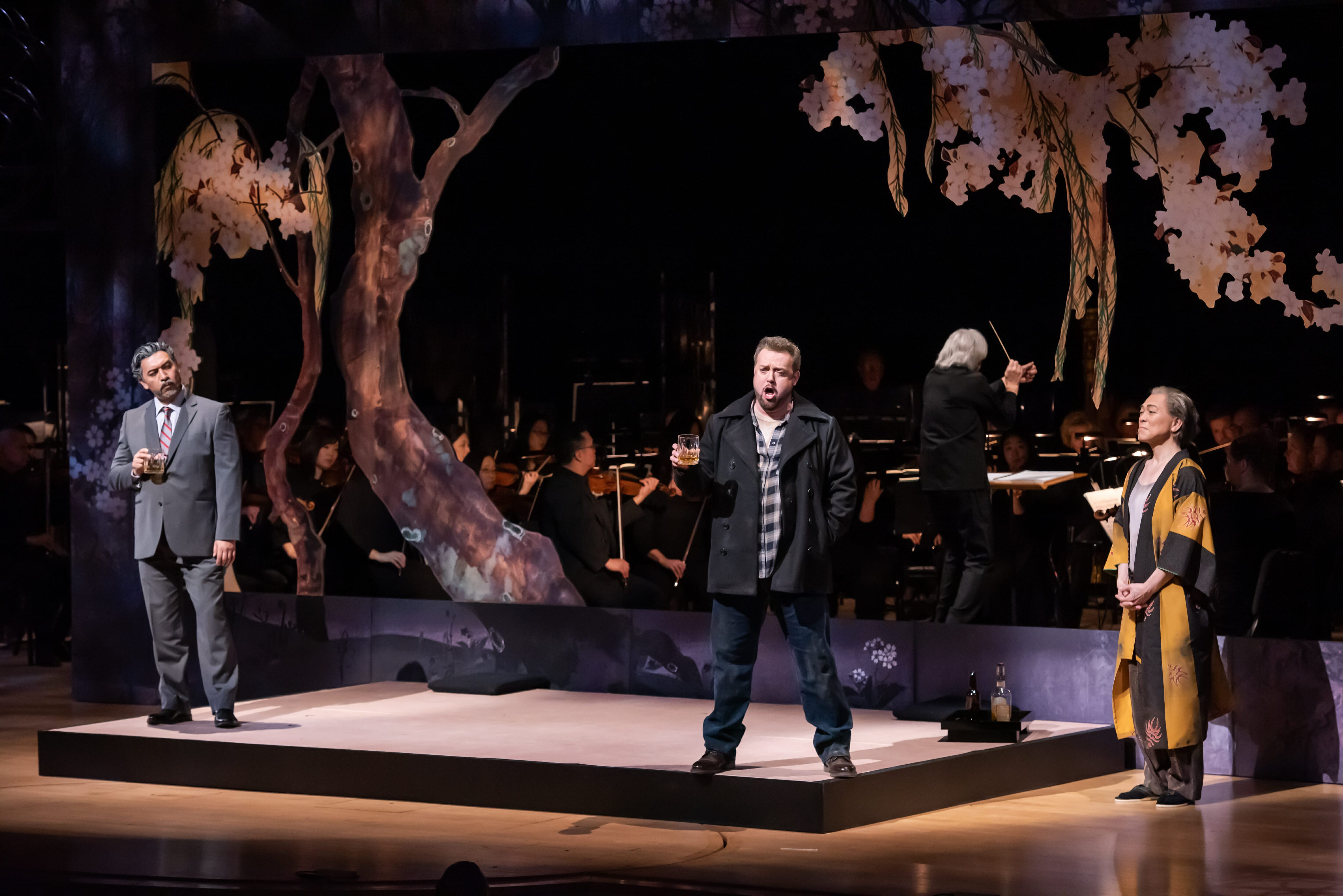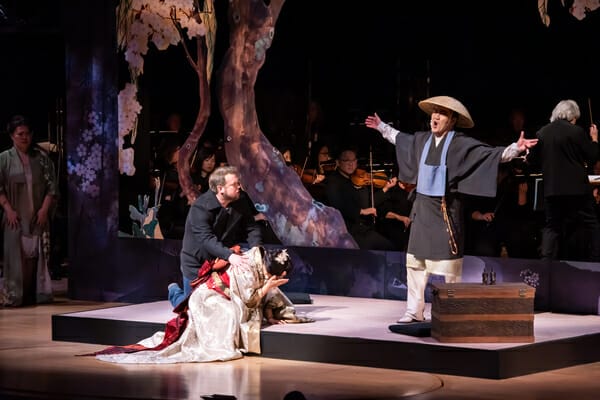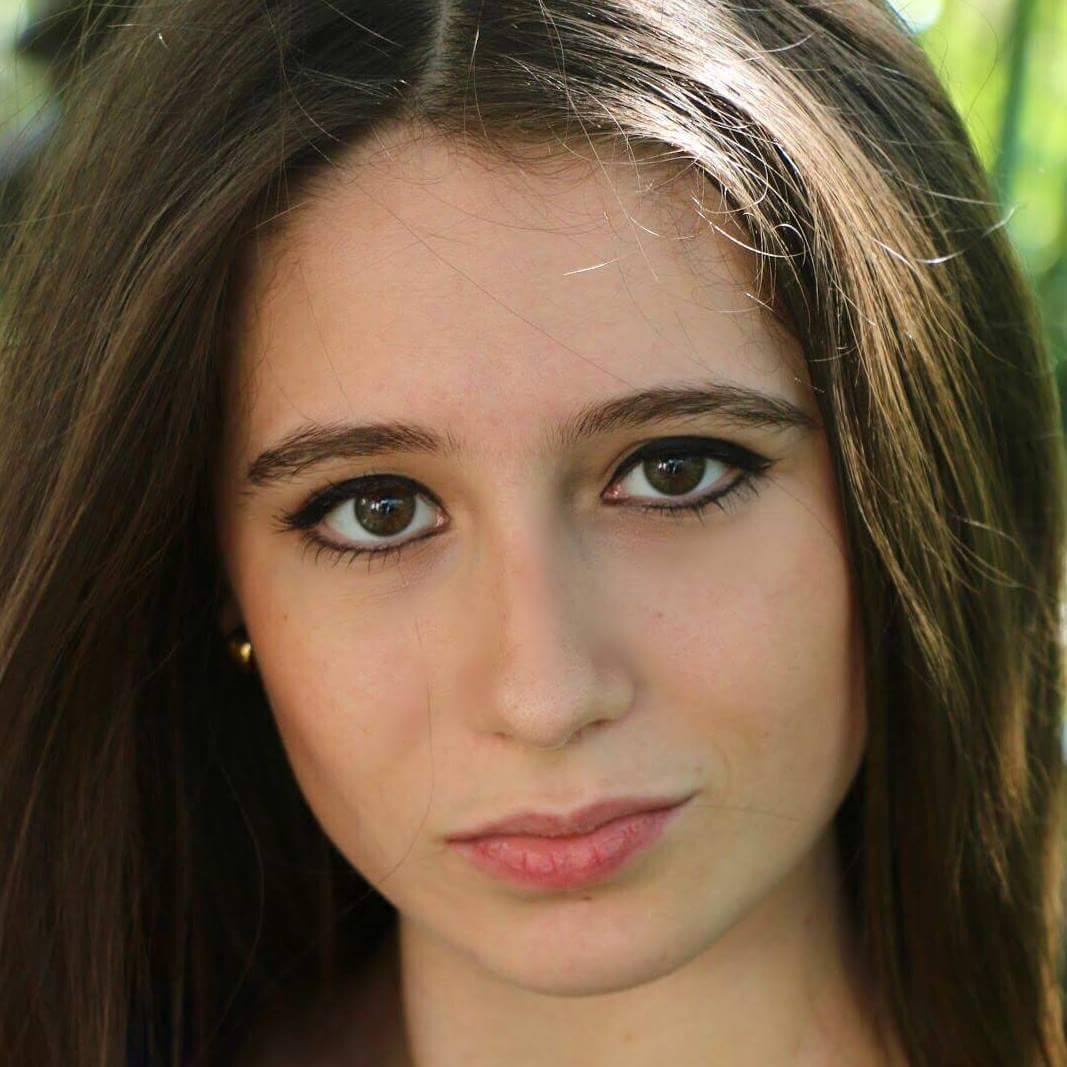The elegant outdoor arts plaza outside Segerstrom Concert Hall seemed the propitious setting for the Pacific Symphony’s performance of Madame Butterfly. Its centerpiece is a sibylline fountain, its lithe jets creating streaming arcs from one side to the other against the imposing cool glass and beige structure of the hall.
Southern California audiences have long been at home with the merging of the modern with the traditional, a blend that last night's performance happily managed. Inside, some attendees took advantage of the opera’s Japanese backdrop to wear outfits with oriental accents, a reminder that the opera hall as the place to see and be seen, born out of the spirit of the 19th century, lives on in 21st-century Santa Ana.
Dramatic Context from a Radio Presenter
The venue itself, though nodding to old opera houses with seats of scarlet red velvet and blond maple wood panelling, is a modern symphony hall with cool silver-leafed canopies designed to be adjusted for acoustical purposes. As the public straggled in, some early arrivers had the chance to enjoy a preview talk presented by KUSC radio show presenter Alan Chapman, who stood like a magician in front of a small red curtain that mysteriously covered the first set. The talk was ideally suited to the uninitiated as well as to the casual opera-goers who were in need of a little dramatic and musical context. Mr. Chapman highlighted a few of Puccini’s melodies that have cast an irresistible spell over audiences and he provided some information on the dramatic origins of the opera. In this way, he implicitly aligned the effectiveness of Puccini’s score with the composer’s remarkable instinct for drama, the delineation of character and place through orchestral timbre and thematic material, and a sense of pacing which builds to transcendent and heart-wrenching conclusions.
The tragic love story of caddish American Lieutenant Pinkerton and 15-year-old Japanese Cio-Cio-San (or Butterfly), as she is sold in marriage in Nagasaki through the opportunistic real estate agent and marriage broker Goro, features the tensions between the confrontation of Eastern and Western cultures. More essentially, the opera depicts the spiritual calamity of experiencing love from incompatible points of view. Pinkerton cynically toasts the “real” American wife with whom he wants to build his life moments before his marriage to Cio-Cio-San. He sings an impetuous ode to enjoying the moment with no regard to consequences (“Amore o grillo” or “True love or fancy”) to the alarm of his confidante, the US consul Sharpless, while Cio-Cio-San proves her devotion by swearing off her ancestral religion and converting to Christianity, to the wrath of her family. Pinkerton’s adventurism has birthed a relationship based on
pretense, but Butterfly has a trusting heart and embellishes reality with hope and faith, as in her aria “Un bel di vedremo” (“One Fine Day”). Pinkerton leaves her, with many assurances that he will return, and Butterfly bears his son in his absence. She waits for three years with her maid as she endures increasing poverty and taunts, especially when she loyally spurns the advances of a wealthy man (Prince Yamadori played ably by Yunpeng Wang). Pinkerton eventually comes back to Nagasaki, but only to make arrangements to bring his child to America and have him raised by his new American wife Kate (played by Karin Mushegain). Pinkerton realizes that Butterfly still loves him and, cowardly, makes Kate and Sharpless break the news. Cio-Cio-San agrees to give up the child if Pinkerton promises to see her one last time. Before he rushes to her side, she commits suicide with a seppuku knife -- the same knife her father used to kill himself when he lost all honor in life.
The Direction
The evening began in silence, with the steps of the singing actors resounding throughout the hall. Eric Einhorn, the stage director, decided to open with an unhabitual prologue; Pinkerton, dressed in a grubby outfit consisting of a leather jacket and ill-fitting jeans, leered at four young Japanese girls dressed in slips while the marriage broker Goro rubbed his hands together mendaciously. With a theatrical gesture, the red curtain was removed to reveal a flimsy, semi-stylized screen with floral accents and a cutaway, through which music director Carl St. Clair energetically conducted the opening fugato.
In this writer’s opinion, the hall, however impressive, is not especially well- suited to the elaborate sets associated with opera. Einhorn and Cameron Anderson, the scenic designer, had to work against the spacious architecture to bring theatrical interest to the production. They came up with pungent details that suggested rather than richly illustrated scenes, including wafts of pink and white cherry blossoms born by attendants of the wedding party through the aisles. As the girls brushed past the audience, with their long hair pulled back and adorned with flowers to suggest the festivity of a wedding scene, one had the impression that the moment was quasi-participatory. The costumes by Katie Wilson represented the characters accurately. Although, to this reviewer, the marriage broker’s orange and yellow garb looked more like a Mexican poncho than a traditional yukata, a white kimono replete with a long train suited Madame Butterfly as an innocent bride in the first act, while her red, simple house-dress in the second and third acts connoted the entrapment of an unloved housewife. Kathy Pryzgoda, the lighting designer, lent the love duet of the first act the requisite soft blue tones, while Dani Reynolds, the properties coordinator, provided enough elements (chairs and a table, a TV set, etc) to give the appearance of stark domesticity.
In this production, the poetic dimension of the work was mainly relegated to the musical realm. The scene during which Butterfly decorates her home with flowers along with her maid in preparation for Pinkerton’s return,
for example, did not feature the awaited petals or flower garlands of peach blossom, violets, and jasmine in the libretto. They were transformed into artificial roses, the wire stems sticking out on the brightly lit stage floor. Such a directorial bent was intentional, as Einhorn voiced in the program notes what he perceived as a tension between past and present interpretations of the work: “Racism, misogyny, physical and emotional abuse, and (in the case of Madame Butterfly) pedophilia run rampant through musical scores we all hum along to thanks to our favorite cartoons and TV commercials. So what do we do?” Einhorn’s response was to de-emphasize the aspects of the drama that affirm the telling of a psychological drama of doomed disillusionment -- a theme that renders the subject universal and intransient and therefore unresponsive to socio-political commentary. Under Einhorn’s direction, such quaint phrases in the libretto as "quel fare di bambola" (that doll-like behavior) and "l'esotico suo odore" (her exotic odor) regarding Pinkerton’s infatuation with Butterfly took on a particularly dark and objectifying meaning. Pinkerton was conceived as an unapologetic boor rather than a manipulative charmer, an emblem of the callous attitudes of colonists who trample on sacred ground -- both the affective realm of Cio-Cio-San’s heart as well as the cultural landscape of Nagasaki and its customs. Although John Pickle possessed a handsome tenor, he was made out to be so unattractive and villainous that the audience booed his performance. In other words, Pickle sounded like an ardent hero and looked and behaved like a clumsy debauchee. His disregard for his new bride’s traditional items were amplified in a stage comportment that mimicked the demeanor of a boorish truck-driver. Meanwhile, instead of maximizing the impact of his wonder-filled and ecstatic phrases during the love duet, in order to match the deceitful charm of Puccini’s music on the listener, Einhorn had Pinkerton guzzle beer and undress to reveal a wifebeater clinging to his middle as he lustfully pawed at Cio-Cio-San’s figure. In this reviewer’s opinion, such a portrayal of Pinkerton, however novel, has its drawbacks; a manifestly cruel Pinkerton does not allow us to comprehend why Cio-Cio-San’s sacrifices should inspire such pity if her mistakes are foreseeable.
Perhaps Einhorn meant to persuade the viewer of the inevitability of Butterfly’s choices within a confining social construct. The clinical set of the second act reinforced this theme. On the white walls, tally marks representing days had been scribbled as if by a mental asylum patient or a jail inmate. Accompanied by a hollow and wraithlike fugato prelude, the set appeared particularly depressing and mirrored the triviality and senselessness of Cio-Cio-San’s death scene. The moment passed prosaically in front of the TV in conflict with the music, which left no doubt as to the tragedy of the moment, while Butterfly’s child, mimed by Annabella Chou, sat totally unresponsive, like a contemporary tot zoned out from video-games.
The Cast
Some of the singers infused their musical numbers with a pathos that complimented the bleakness of the director’s vision. In “Addio, fiorito asil”, Pinkerton’s sudden acknowledgment of his misguided behavior played out as a tragic echo of the luminous love duet, as if its rapture had given his feelings a seductive veneer of sincerity that could not match Butterfly’s unwavering love. In his final aria, Pickle briefly enacted the self-disgusted regret of a man who is not a hero, and who recognizes the nobility of love too late. Meanwhile, Yunah Lee made a great impression on her audience as Cio-Cio-San. Puccini’s prismatic focus on his tragic heroine is incredibly demanding, and requires the ability to bridge from the lyricism of her ethereal entrance to a dramatic, spinto quality of voice that will sustain the grief of a mother robbed of honor and of a reason to live. Perhaps Lee erred on the lyric side and shone best when she displayed sweet vulnerability and grace, as in her charming enactment of the moon’s rise that seemed to be influenced by Jinta mai style dancing. She seemed to show signs of exhaustion by the end of her physically, vocally, and emotionally demanding role -- even at the start, she did not ascend to the optional high D-flat at what could have been the exquisite apex of her opening aria. In this writer's view, however, she could not be accused of not giving a lot of herself. The parting moments spent with her child, which run the danger of becoming mawkish, were played with desperation and tenderness.
Another notable member of the cast included Cio-Cio-San’s servant Suzuki as played by mezzo soprano Sabina Kim. She sang with assurance and a sympathetic warmth, lending dignity to her struggles to shield Cio-Cio-San from the news of her husband's betrayal. Joseph Hu chose to play Goro, the wheeler-dealer who sells Butterfly to Pinkerton, as a snippy and caricatured version of an expedient leech. Luis Ledesma’s Sharpless, with his dual nature as a figure of authority and a kind guardian, prioritized a stern rigidity. For some reason, Hyung Yun’s Bonze -- the terrifying religious priest and uncle to Butterfly
who disowns her -- was not very threatening, but strode onto the stage from the wings in a rice-picker hat and left as discreetly as he came when Pinkerton ordered him out.
The Capable Leadership of Conductor St. Clair
While the orchestra’s placement onstage sometimes overpowered the singers’ efforts, the audience had a rare opportunity to hear all of the nuances that are usually muffled below the stage, such as touches of flute, piccolo, harp and glockenspiel accompanying Butterfly’s entrance and the use of Japanese bells in the wedding scene. Conductor St. Clair managed all of these finer details with brisk efficiency, pacing the rising and falling intensity of the music without drawing attention to himself. In this reviewer’s opinion, he could have luxuriated further in the sensual qualities of the love duet and flower scene, although perhaps his purposeful tempi had more to do with accommodations to his singers than an artistic choice. The Pacific Chorale was led by Robert Istad and produced stellar results, especially in the humming chorus, which had a gossamer quality and infused Butterfly’s wait for Pinkerton with a noble beauty.
In a break from tradition, conductor St. Clair also made the decision to adhere to the composer's original intention to divide the work into two acts instead of three, which meant that the second half clocked in around an hour and a half. It was a long evening, but the audience was visibly moved.
To many present, the brief happiness that Butterfly experienced during her wedding night inspired intense pity, because they knew that these episodes were ephemeral. Through his compositional and dramatic efforts, Puccini codifies beauty and its ancilla - pity - into art that embeds such moments in the present.
The next opera produced by the Pacific Symphony, Maurice Ravel’s L'enfant et les sortilèges, allows us to inhabit quite another and perhaps more family-friendly experience -- that of a boy bombarded with magical happenings. Will you see and hear for yourself the transformative nature of live opera?
RECOMMENDED
Composer: Giacomo Puccini
Conductor: CARL ST. CLAIR
PRODUCTION
Director: Eric Einhorn
Scenic Designer: Cameron Anderson
Costume Designer: Katie Wilson
Lighting Designer: Kathy Pryzgoda
Properties Coordinator: Dani Reynolds
Cast: YUNAH LEE, JOHN PICKLE, SABINA KIM, JOSEPH HY, LUIS LEDESMA, YUNPENG WANG, HYUNG YUN, JANE SHIM, KARIN MUSHEGAIN, ARAM BARSAMIAN, RANDALL GREMILION, MATTHEW KELLAWAY, ELEEN HSU-WENTLANDT, CHELSEA CHAVES, ANNABELLA CHOU
UPCOMING Pacific Symphony Opera production (L'enfant et les sortilèges)
When:
Various dates and times from May 16th to May 18th, 2019.
Where:
Segerstrom Center for the Arts
600 Town Center Dr, Costa Mesa, CA 92626
Tickets:
Tickets start at $71.
To purchase tickets or to see more of the wealth of concert events taking place at Segerstrom, visit The Pacific Symphony website or call the Box Office at (714) 755-5799.
About the Author
Watch this video previewing Picture This Post's OPERAS WE LOVE - roundup.




